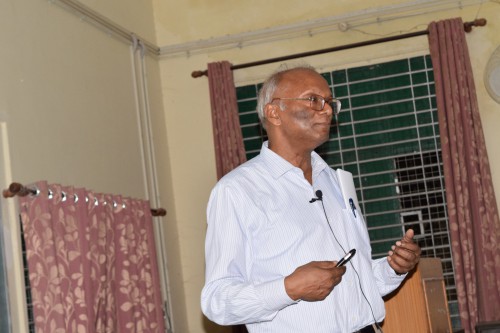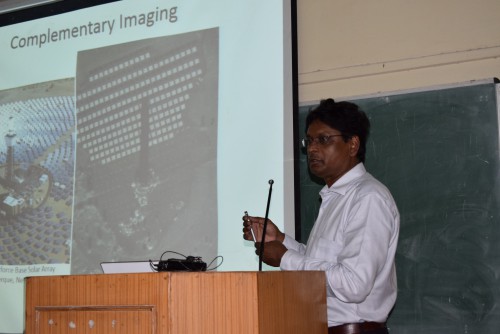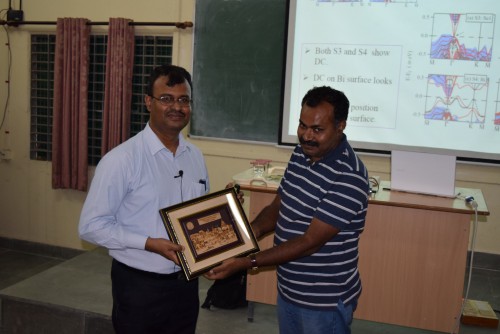Speaker: Prof. Ujjwal Sen, HRI, Allahabad
Date/Time: 10/11/2017 at 05:00 PM
Abstract: The uncertainty relation forms one of the pillars of our understanding of quantum mechanics, and fires the imagination of non-scientists and scientists alike. We discuss the traditional form of the relation, thereby identifying quantum states which were not hitherto encompassed, and which we propose to rectify. The uncertainty relation has important implications for the quantum-to-classical boundary, and we find that the boundary is also modified by going over to the non-traditional form of the relation.
Title: Imaging and Non imaging: Wavefronts without waves
Speaker: Prof. Rajaram Nityananda, Azim Premji University, Bengaluru
Date/Time: 09/10/2017 at 4:30 pm
Abstract: High school geometrical optics is obsessed with the special case when the rays from a single point on an object making small angles to the axis reach a single point on the image. This talk will give a glimpse of the world beyond this restriction. Forming good images with rays making a large angle is important for both telescopes and microscopes. Rays from a distant quasar (bright centre of a galaxy) get bent by the gravity of an intervening galaxy and do not form an image in the usual sense. And if one wants to concentrate sunlight from a large area onto a smaller one, the best solution is not to image at all! The key to a deeper understanding and use of geometrical optics in such situations is the existence of surfaces perpendicular to a family of rays - wavefronts without waves.
Title: Optical Solitons and Modulational Instability: Ultra Pulse Generation and Supercontiuum Generation
Speaker: Prof. K. Porsezian, Department of Physics, Pondicherry University
Date/Time: 20/04/2017 at 05:00 PM
Abstract: In this talk, I would like to discuss the role of optical solitons and modulational Instability (MI) in nonlinear optical fiber. Considering different types of nonlinear Schrödinger equation with different linear and nonlinear optical effects, I will discuss the role of MI and generation of solitons. In particular, I will discuss the side band generation in nonlinear optical fiber and controlling of these side bands. The theoretical investigation of nonlinear femtosecond pulse propagation in liquidcore photonic crystal fiber will be discussed in detail. Finally, I will discuss supercontinuum generation through MI induced spectral broadening process. The effect of saturable nonlinearity and slow nonlinearity due to reorientation contribution of liquid molecules on broadband supercontinuum generation in the femtosecond regime will be discussed using an appropriately modified nonlinear Schrödinger equation.
Title: The Mysterious Magnetic Personality of Our Sun
Speaker: Prof. Arnab Rai Choudhuri, Dept. of Physics, Indian Institute of Science, Bangalore
Date/Time: 20/10/2016 at 05:00 PM
Abstract: The Sun is the first astronomical object in which magnetic fields were discovered in 1908 by using the Zeeman effect. Even before this discovery of magnetic fields in sunspots, it was known that there is a 11-year cycle of sunspots, which could be identified as the magnetic cycle of the Sun after this discovery. The magnetic field of the Sun is also behind many other phenomena, such as the violent explosions known as solar flares, the corona much hotter than the solar surface and the solar wind. Only within the last few decades, major developments in plasma physics and magnetohydrodynamics (MHD) have at last provided a broad framework for the theoretical understanding of these phenomena connected with the solar magnetic fields. I shall give a general introduction to this field – with some emphasis on the research interests of our group. A more detailed account of this field can be found in my recently published popular science book:
http://www.amazon.in/Natures-Third-Cycle-Story-Sunspots/dp/0199674752/
Title: When you need a physicist, not a physician, to cure a disease
Speaker: Prof. Sudipta Maiti, Dept. of Chemical Sciences, TIFR, Mumbai
Date/Time: 03/10/2016 at 12:00 Noon
Abstract: Despite billions of dollars spent on medical research, medicine still has no cure for diseases of the brain such as Alzheimer’s and Parkinson’s. They seem to be caused by our own proteins, and not by external infectious agents. In the patients, these proteins become sticky, aggregate together and start killing neurons for some unknown reason. Perhaps these diseases will only be solved when we really understand the structure and properties of these molecules in different aggregated states. By combining a range of powerful techniques borrowed from physics, starting from single molecule fluorescence to solid state NMR, we are now beginning to unravel the structure of the toxic molecular aggregate.
Title: Energy, Environment and Piezoceramics
Speaker: Prof. Ajit R. Kulkarni, Dept. of Metallurgical Engineering and Materials Science, IIT-Bombay, Mumbai
Date/Time: 28/09/2016 at 12:00 Noon
Abstract: Energy crisis have affected the globe primarily due to sources that supply national electricity grids or those used as fuel in vehicles. Industrial development and population growth have led to a surge in the global demand for energy. To partially overcome stress on these natural resources, renewable sources of energy including waste heat, vibration, electromagnetic waves, wind, flowing water, and solar energy are used. In recent years emphasis is on scavenging vibrational/mechanical energy with piezoelectric materials and apply it to self-power micro-devices instead of batteries. Piezoelectric ceramic is the heart of these energy harvesters. In this talk, I shall speak on the state-of-the-art in piezoelectric energy harvesting, the basic material characteristics, discuss material choices and their forms. Piezoelectric LeadZirconateTitanate (PZT) is widely used. However, due to high toxicity of lead oxide, pollution and environmental problems there are restriction on its use, development and disposal. Hence environmentally friendly lead free materials are of current interest.
At IIT Bombay, our group is actively working on engineering lead free alkali niobates, their modified and a few composites as alternative to Lead based materials. Our strategies to enhance materials characteristics through processing, composition modification and electrical properties will be discussed. Finally, opportunities in this harvesting technique will be presented.
Title: Assisted-hopping models of active-absorbing state transition on a line
Speaker: Prof. Deepak Dhar, Dept. of Theoretical Physics, TIFR, Mumbai
Date/Time: 16/09/2016 at 05:00 PM
Abstract: I will describe a class of assisted hopping models in one dimension in which a particle can move only if it has exactly one occupied neighbour, or if it lies in an otherwise empty interval of length less than or equal to (n+1). This system undergoes a phase transition as a function of the density $\rho$ of particles, from a low-density phase with all particles immobile for density below a critical density, to an active state for densities greater than the threshold value. I will describe the exact solution of this problem, where we can determine exactly the critical density, and the average activity as a function of density in the active phase. There is a mapping to a gas of defects with only on-site interaction. The mean fraction of movable particles in the active steady state varies as $(\rho - \rho c)^{\beta}$, for $\rho$ near $\rho_c$. We show that for the model with range $n$, the order parameter exponent $\beta$ equals $n$, and can thus be made arbitrarily large.

Title: SAR Image Formation
Speaker: Prof. S.K. Patra, Scientist 'G', Group Director, Sensor Data Processing Group, Advanced Data Processing Research Institute (ADRIN), 203, Akbar Road, Manovikas Nagar Post, Secunderabad, Hyderabad
Date/Time: 02/09/2016 at 05: PM
Abstract: Synthetic Aperture Radar (SAR) payload in space is usually a multiresolution, multi-swath, multi-mode, multi-polarization system carrying an active antenna on-board to image the ground in microwave frequencies. SAR transmits pulses of microwave radiation to a target and receives backscatter in the form of amplitude, phase with a time delay in the returned signal. The transmitted linearly frequency modulated long pulse in range or across the flight direction views the target for longer duration whereas SAR’s principle of synthesizing the long aperture to achieve finer resolution in azimuth or flight direction increases target dwell time. Together, target history is spread in across track and along track directions in the received signal. SAR algorithms convert raw signal data to interpretable detected images which requires significant processing after acquisition. The presentation will deal with the principles of SAR imaging and techniques used to form SAR images from raw signal data.

Title: Topological insulators and their aging
Speaker: Prof. Kalobaran Maiti, Dept. of Cond. Mat. Physics and Mat. Science, TIFR, Mumbai
Date/Time: 26/08/2016 at 05:00 PM
Abstract: Insulators are materials having an energy gap between the highest occupied band (valence band) and the lowest unoccupied band (conduction band). Topological insulators are a special type of such materials, which possess gapless states with novel electromagnetic properties protected by time reversal symmetry at the surface of bulk insulators. Enormous research has been carried out on these materials as they are expected to bring immense technological advances and new possibilities in the fields of spintronics, quantum computation, dissipationless charge transfer etc. Since the surface states of topological insulators are time reversal symmetry protected, they are expected to be immune to weak disorder, chemical passivation of the surface or temperature change. However, significant discrepancy from such behaviour has been found experimentally in various materials. We studied the detailed electronic structure and its aging of a topological insulator, Bi2Se3 employing high resolution photoemission spectroscopy. Both the band structure results and high resolution angle resolved photoemission data reveal significantly different surface electronic structure for different surface terminations. Furthermore, oxygen impurity on Se terminated surface exhibits an electron doping scenario, while oxygen on Bi terminated surface corresponds to a hole doping scenario. The intensity of the Dirac states reduces with aging indicating fragility of the topological order due to surface impurities.

Title: States and Phases of Matter and Phase Transition
Speaker: Prof. Y. Singh, Distinguish Professor, Dept. of Physics, Institute of Science, BHU, Varanasi
Date/Time: 17/08/2016 at 02:30 PM
Abstract: The talk will focus on basic concepts associated with states and phases of matter. Through few examples of phase diagram and phase transitions the significance of symmetry breaking, order parameters, emergence of new properties, etc. will be explained. Theories which describe phase transitions may also, at elementary level, be discussed.


